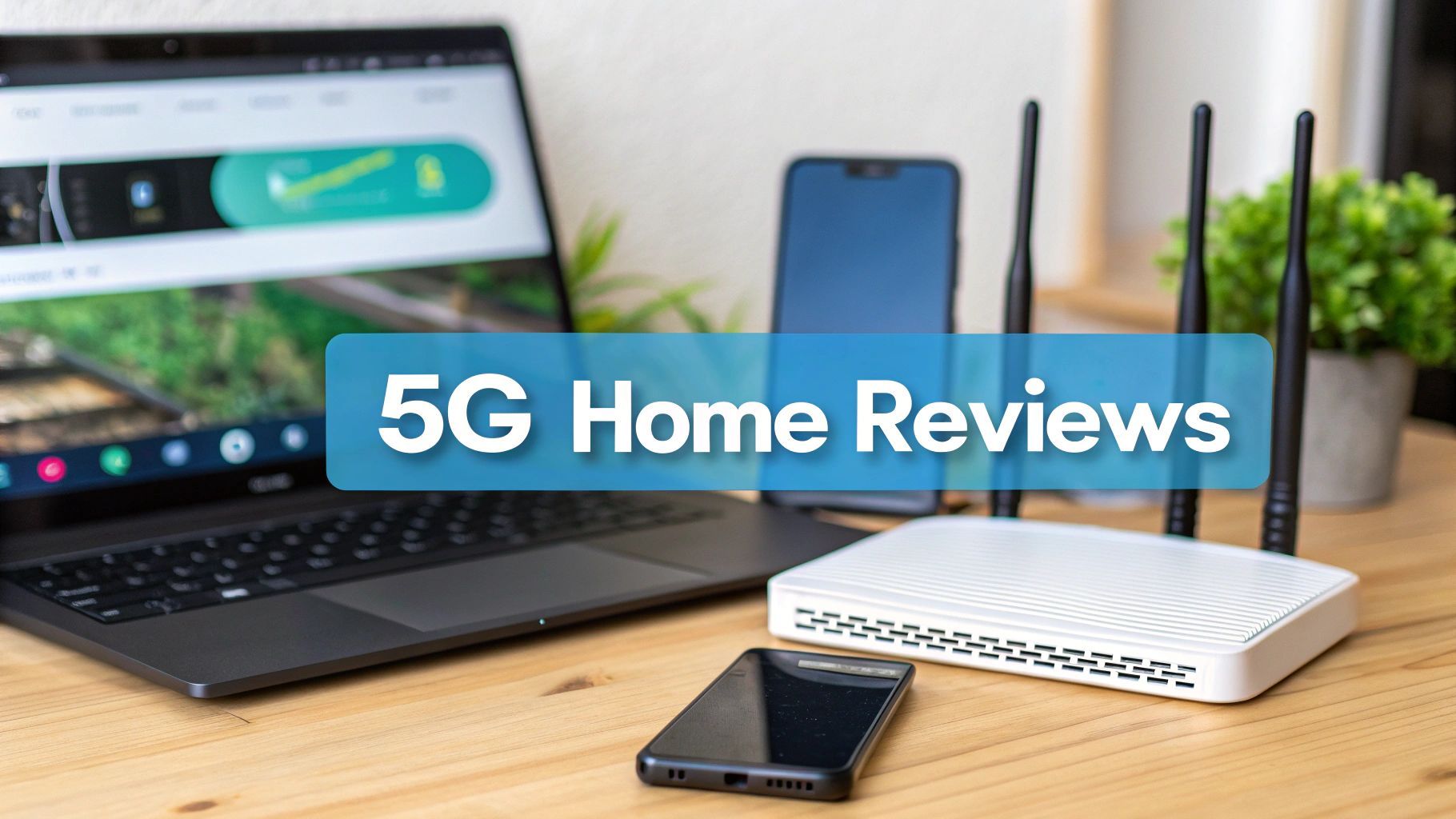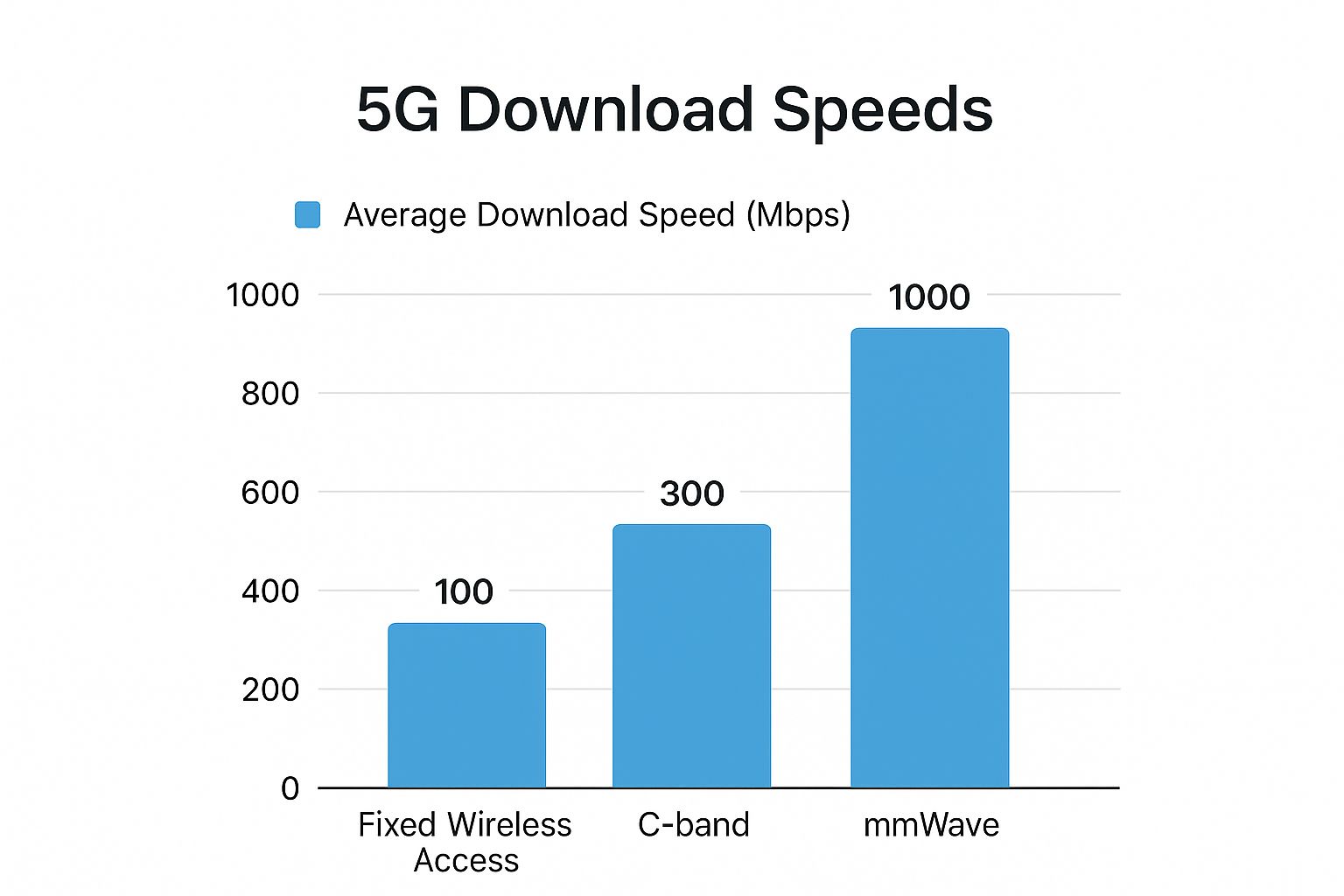

· By James
5G Home Internet Reviews You Can Actually Trust
When you sift through 5G home internet reviews, one thing becomes clear: this isn't just a niche product anymore. It's a genuine, powerful alternative to the cable and DSL plans many of us have been stuck with for years, especially if you live in an area where good internet is hard to come by. The appeal is pretty straightforward—you get solid speeds, a setup that's basically just plugging something in, and monthly bills that are often easier to swallow. It's a compelling mix for all sorts of people, from remote workers to full-time RVers.
Is 5G Home Internet a Smart Move for You?
So, what exactly is 5G home internet? The technical term is Fixed Wireless Access (FWA), but all that really means is you're getting broadband internet through cellular networks instead of physical cables running to your house. A small gateway device in your home picks up 5G signals from a nearby cell tower, giving you a simple, often cheaper, connection.
And people are catching on. By the end of 2023, more than 4 million U.S. households had already made the switch, which tells you a lot about its growing appeal. Much of that growth comes down to providing cable-like speeds without the hassle of scheduling a technician. If you want to dive deeper into the adoption trends, patentpc.com has some great insights, including how T-Mobile is leading the pack with over 3 million subscribers.
Who Benefits Most From 5G Internet?
While 5G internet can work for almost anyone, it’s a total game-changer for a few specific groups who’ve long been stuck with slow, unreliable options.
- Rural Residents: If you live outside the reach of fiber or cable, 5G is often the first real taste of high-speed, dependable internet you can get.
- RV Travelers: The portability is a huge plus. Its plug-and-play setup makes it incredibly easy to stay connected while you’re on the move.
- Budget-Conscious Users: Plans frequently start around $50 per month—and can be even cheaper if you bundle with a qualifying mobile plan. That’s a serious saving compared to a lot of cable providers.
- Renters and Frequent Movers: No long-term contracts and a simple self-install process make it perfect for anyone who doesn't want to deal with installation appointments or being tied down.
Of course, the big question for most people is how it really stacks up against more traditional internet like fiber. It’s a valid debate, and our detailed breakdown of 5G home internet vs. fiber can help you sort through the pros and cons.
Top 5G Home Internet Providers at a Glance
To give you a quick lay of the land, here’s a high-level comparison of the leading providers. This should help you quickly see which options might be the best fit for your home.
| Provider | Starting Price | Typical Speeds | Best For |
|---|---|---|---|
| T-Mobile | $50/month | 72-245 Mbps | Simplicity and Price Lock Guarantee |
| Verizon | $50/month | 85-300 Mbps | Performance and Mobile Bundles |
| AT&T | $55/month | 75-225 Mbps | Straightforward Pricing |
Each provider has its own strengths, whether it's T-Mobile's price guarantee, Verizon's performance edge, or AT&T's no-fuss pricing. The best choice ultimately comes down to what's available in your area and what you value most in an internet service.
Getting a Handle on the Tech Behind Your Connection
To really make sense of 5G home internet reviews, it helps to peek behind the curtain at what's actually going on. This service is built on something called Fixed Wireless Access (FWA). In simple terms, your internet signal travels through the air from a nearby cell tower straight to a gateway device in your home. It’s a completely wireless setup that cuts the cord on physical cables.
This wireless delivery relies on different radio frequencies, often called "bands," to get data to you. Each band is a different tool in the toolbox, offering its own unique blend of speed and coverage that directly shapes your day-to-day online experience. You can think of them as different lanes on an internet highway.
The Different Flavors of 5G
It's a common misconception that all 5G is the same. It’s not. The type of signal your provider uses is the biggest factor determining your connection's performance, and there are two main varieties you'll see mentioned in reviews.
- C-Band (Mid-Band): This is the real workhorse of 5G home internet. C-band hits the sweet spot between speed and range, giving you a serious performance bump over old-school 4G LTE while still blanketing large areas. For most homes, this is the ideal setup, easily handling multiple 4K streams, intense online gaming, and a household full of video calls all at once.
- Millimeter Wave (mmWave): Now this is the express lane. mmWave delivers mind-blowing, fiber-optic-like speeds, but there's a catch: its range is incredibly short. It also struggles with physical obstacles—we're talking walls, trees, even a heavy downpour can interfere with the signal. Because of this, you’ll typically only find it in densely packed urban areas, stadiums, or specific downtown cores.
“Figuring out whether your provider is using C-band or mmWave in your neighborhood is absolutely critical. It’s the single biggest factor that tells you if you’ll get solid, reliable speeds or a connection that’s just plain frustrating.”
This infographic gives you a clear picture of the average download speeds you can expect from these different 5G technologies.

As you can see, the performance gap between the technologies is huge. mmWave can offer speeds 10 times faster than standard FWA, which is exactly why it pays to know what your local network is actually capable of before you sign up.
The build-out of these 5G networks has been happening at a breakneck pace. Global 5G wireless connections are on track to hit 2.25 billion by the end of 2024—an adoption rate four times faster than 4G LTE ever was. North America is leading the pack with 289 million connections, now covering 77% of the population.
Of course, getting the right technology is only half the battle; you also need the right hardware to make the most of it. Our guide to the top 5G WiFi router picks for faster home networks can help you pair your service with a device that maximizes whatever signal is available to you.
T-Mobile vs. Verizon vs. AT&T: Who Really Wins the 5G Home Internet Battle?
When you start digging into 5G home internet reviews, you’ll quickly find the conversation dominated by the big three: T-Mobile, Verizon, and AT&T. They all promise lightning-fast, revolutionary connections, but let’s be real—their services are not created equal. Picking the right one means looking past the flashy speed claims and getting into the details of their network tech, pricing quirks, and the actual hardware they send you.
This showdown breaks down the real-world factors that make or break your daily internet experience. We're going beyond performance numbers to look at the fine print that can make a huge difference, helping you decide which provider actually fits your life, whether you're setting up a home office or hitting the road in an RV.
Performance and Speed Realities
Speed is the first thing everyone asks about, but the numbers in the ads are only half the picture. Your actual, day-to-day performance is all about the kind of 5G network each company has built and, most importantly, where you happen to be. This is where you see the biggest differences pop up.
-
T-Mobile Home Internet: T-Mobile jumped into the 5G game by snapping up a massive chunk of mid-band spectrum, which is the secret sauce behind its huge nationwide 5G footprint. This strategy gives most users a really consistent and dependable connection, with typical download speeds landing in the 72-245 Mbps range. It’s a true workhorse for streaming, working from home, and everyday browsing.
-
Verizon 5G Home Internet: If you're chasing the highest possible speeds, Verizon is often the one to beat, especially in cities and packed suburbs. They lean heavily on C-band and mmWave technology, which can crank out insane download speeds—often hitting 300 Mbps and sometimes even touching gigabit speeds in the right spots. The catch? This high-octane network doesn't reach nearly as far, so getting it can feel like winning the lottery.
-
AT&T Internet Air: AT&T is the newer kid on the block in the 5G home internet scene, and they’ve taken a more middle-of-the-road approach. Their speeds are solid, usually landing somewhere between 75-225 Mbps, putting them right in line with T-Mobile. They’re using their existing cell network to offer a simple, reliable service that’s more about dependability than breaking speed records.
Pricing Structures and Hidden Costs
At first glance, the pricing from all three looks pretty similar, kicking off around $50 to $60 a month. The real story, though, is in the bundles and special offers. That’s where you can find some massive differences in what you'll actually pay.
T-Mobile’s “Price Lock Guarantee” is a huge deal. They promise your monthly rate won't go up for as long as you're a customer. In an industry known for surprise price hikes, that kind of peace of mind is pretty rare.
Verizon gets really aggressive with its bundles. If you have one of their premium mobile plans, you can often knock the internet price down to just $25-$35 a month. If you’re already a Verizon mobile customer, this is almost impossible to beat.
AT&T also offers discounts for bundling with their mobile service, but they're usually not as deep as Verizon's. Their main selling point is clear, straightforward pricing without a bunch of confusing tiers, which a lot of people find refreshing.
Data Caps and Equipment Quality
One of the best things about switching to 5G home internet is saying goodbye to the annoying data caps you see with cable and satellite. All three of these providers give you unlimited data with no overage charges, which is a massive win for anyone who streams a lot, games online, or has a house full of connected devices.
The gateway (modem/router combo) they give you matters, too.
- T-Mobile: Ships a gateway that’s super easy to use, with a handy little screen that shows your signal strength so you can find the best spot for it. Some of their older models even had ports for external antennas, a feature that RVers and people in fringe signal areas absolutely loved.
- Verizon: Their gateways are known for being solid and offering more advanced settings. This is great for the tech-minded folks who like to fine-tune their home network.
- AT&T: The AT&T gateway is all about simplicity. It’s a clean, effective device that you set up with a mobile app, making it a true plug-and-play experience for anyone who doesn't want to mess with settings.
Ultimately, T-Mobile has the broad, reliable coverage with a price you can count on. Verizon is the undisputed speed champ if you’re lucky enough to be in its coverage zone, especially if you bundle. And AT&T offers a simple, no-nonsense option that just works.
To make things a bit clearer, let's break down the key differences in a table. This gives you a quick, at-a-glance look at what each provider brings to the table across the most important categories.
Detailed Provider Feature and Performance Breakdown
| Feature | T-Mobile | Verizon | AT&T |
|---|---|---|---|
| Typical Download Speed | 72–245 Mbps | 85–300 Mbps (can exceed 1,000 Mbps in mmWave areas) | 75–225 Mbps |
| Network Technology | Primarily Mid-Band 5G | C-Band & mmWave 5G | Mid-Band 5G |
| Coverage Focus | Broadest national 5G coverage | Dense urban & suburban areas | Balanced national coverage |
| Standard Pricing | $60/month ($50 w/ AutoPay) | $60/month ($50 w/ AutoPay) | $55/month (includes AutoPay) |
| Best Bundle Discount | Down to $40/month | Down to $25-$35/month | Down to $35/month |
| Key Differentiator | Price Lock Guarantee | Highest potential peak speeds | Simple, straightforward service |
| Data Caps | None | None | None |
| Equipment | User-friendly gateway with signal display | Robust gateway with advanced settings | Simple plug-and-play gateway |
This table helps put it all in perspective. While the numbers tell part of the story, your own location and needs will be the deciding factor. Verizon might be the fastest on paper, but if they don't serve your address, T-Mobile's wider reach and price guarantee could easily make it the better choice.
How 5G Performs in the Real World

Advertised speeds are just numbers on a page. The real question is, how does your internet hold up during a family movie night, a crucial work video call, or when the entire household is online at once? This is where real-world performance separates the contenders from the pretenders in any honest 5G home internet reviews.
Instead of just looking at speed tests, let's dig into the practical, demanding scenarios that make up our daily lives. From streaming and gaming to keeping a smart home humming, this is what you can actually expect day-to-day.
Streaming 4K Movies and TV Shows
High-definition streaming is a major stress test for any internet connection. Just one 4K stream needs a steady 25 Mbps, and that's before anyone else in the house even thinks about picking up their phone or laptop.
For a family that's streaming on multiple TVs, a solid 5G connection is a must. Providers like Verizon and T-Mobile, with typical download speeds often clearing 100 Mbps, can usually handle two or three 4K streams at the same time without that dreaded buffering wheel. The real test, though, is consistency during peak evening hours when network congestion can occasionally cause things to slow down.
Competitive Online Gaming and Latency
Ask any serious online gamer, and they'll tell you low latency—or ping—is way more important than raw download speed. Latency is the delay between your action and the server's response. High ping equals frustrating lag.
This is one area where 5G home internet can be a bit of a mixed bag. While the download speeds are fantastic, 5G latency usually hovers between 20-50ms. That’s a step behind fiber's sub-10ms performance. It's perfectly fine for most online fun and casual gaming, but highly competitive players might feel a slight disadvantage in fast-paced shooters where every millisecond counts.
The real-world difference between 5G and fiber latency can be the deciding factor for competitive gamers. If split-second reactions are crucial, fiber still holds the edge. For everyone else, 5G is more than capable.
Supporting a House Full of Smart Devices
These days, our homes are packed with dozens of connected gadgets—smart speakers, security cameras, thermostats, you name it. Each one puts a small but constant demand on your network's bandwidth, especially your upload speed.
This is a scenario where 5G really shines. With typical upload speeds in the 10-30 Mbps range, it can easily juggle all the data traffic from a fully loaded smart home without slowing down your video calls or movie streams. The capacity of 5G networks is a massive leap forward from older tech like DSL. To see just how big that leap is, take a look at our guide on 5G speeds vs. 4G.
And the technology is only getting better. In fact, by the end of 2024, median 5G download speeds in the U.S. had already hit 388.44 Mbps, a huge jump from the year before. You can dive into more of these trends in this detailed 5G statistics report. This constant improvement shows that wireless internet is quickly becoming more than capable of handling everything we throw at it.
Finding the Best 5G Service for Your Area

Here's the bottom line: the best provider is the one that actually works at your address. A rave review from someone across town doesn't mean much if your home sits in a cellular dead zone. That’s why digging into your specific location is the most critical step you'll take.
Your first stop should be the official coverage maps from T-Mobile, Verizon, and AT&T. These give you the big picture of 5G availability in your neighborhood. But, and this is important, you have to treat them as a starting point, not the gospel truth.
Think of provider maps as a weather forecast. They give you a good general idea, but they can’t predict the exact microclimate in your living room. Obstacles like hills, dense trees, or even certain building materials can weaken a signal that looks strong on the map.
This is exactly why you need to look beyond the slick marketing maps to get a true feel for how the service will perform day-to-day.
Digging Deeper for Local Insights
To get a more accurate picture, you’ve got to pair the official maps with real-world feedback. This is where you'll find genuine 5G home internet reviews from people who live and work right where you do.
Start poking around in local online forums and community groups. Places like Reddit, Nextdoor, or even local Facebook groups can be absolute goldmines for unfiltered user experiences. Just search for terms like "T-Mobile internet" or "Verizon 5G" in those groups and see what your neighbors are saying about their speed, reliability, and customer service.
Pay close attention to the little details in their comments. Do they mention frequent disconnects during prime time? Are they actually getting the speeds that were advertised? This kind of hyper-local feedback is often more valuable than any professional review you'll find.
Urban vs. Rural Coverage Realities
Where you live will fundamentally change the kind of 5G service you can expect. The experience in a packed city is worlds away from a quiet suburb or a rural outpost, so it's crucial to set your expectations accordingly.
- Urban Areas: If you're in the city, you'll likely have access to the fastest C-band and maybe even the ultra-fast mmWave signals. The trade-off? Network congestion can be a real headache, sometimes leading to slower speeds in the evenings when everyone is hopping online.
- Suburban Neighborhoods: Suburbs are often the sweet spot for 5G home internet. Coverage is typically strong and consistent, and with less congestion than a dense city core, you can expect a powerful, reliable connection for the whole household.
- Rural and RV Life: For folks in rural areas or living the RV life, 5G is nothing short of a game-changer. You might not hit the peak speeds of a major city, but the service is often a massive upgrade over ancient DSL or satellite options. Signal strength will vary, which makes tools like the signal meter on T-Mobile's gateway incredibly useful for finding the best spot in your home.
Common Questions About 5G Home Internet
To wrap up our reviews, let’s dig into the questions that almost always pop up when you're about to make a decision. Getting these final details straight can be the difference between a smooth transition and a frustrating surprise.
My goal here is to clear up any lingering doubts you have about the practical side of switching to 5G. It’s a totally different beast than cable or DSL, which means a new way of thinking about setup, gear, and what you’re locked into.
Is the 5G Home Internet Setup Process Really That Easy?
Yes, for the overwhelming majority of people, the setup is dead simple. Providers send you a gateway device, you find a good spot for it near a window, and you plug it into the wall. That’s pretty much it.
They all have mobile apps that walk you through finding the best location for a strong signal. This whole self-install approach means no more waiting around for a technician or having someone drill holes in your walls. Most folks are up and running in under 15 minutes.
Can I Use My Own Router With 5G Home Internet?
Absolutely. The gateway your provider sends you has a Wi-Fi router built-in, but you can usually turn that feature off and plug in your own router or mesh system. This is a huge plus if you’ve already invested in high-end networking gear for better coverage or more advanced controls.
Some gateways make this easier than others. For instance, people have pointed out that some T-Mobile gateways can be a bit tricky, while Verizon's equipment generally gives you more direct control over the built-in Wi-Fi.
This flexibility is key. If you've already perfected your home Wi-Fi with a powerful mesh network, you don't have to start from scratch. You can just plug it into your new 5G service and get the best of both worlds.
Are There Any Data Caps or Contracts to Worry About?
This is honestly one of the biggest reasons people are switching to 5G home internet. Right now, the major players like T-Mobile and Verizon are offering plans with no data caps and no annual contracts. That’s a massive advantage over cable or satellite providers that might slow you down after you use a certain amount of data or lock you into a 1-2 year agreement.
Of course, it’s always smart to read the fine print, as these things can change. Keep an eye out for:
- Trial Periods: Most providers give you a risk-free trial, usually around 15 days, so you can test the service in your own home before you're fully committed.
- Price Guarantees: Look for deals like T-Mobile's "Price Lock," which promises that your monthly rate won't go up for as long as you're a customer.
The no-contract approach makes it a low-risk way to see if 5G home internet works for you, especially if you're trying to find a better solution for a rural home or an RV.
Ready to see if high-speed 5G internet is available for your rural home or next RV adventure? SwiftNet Wifi specializes in bringing reliable connectivity to places traditional providers can't reach. Check your availability and discover a better way to stay connected on the go at https://swiftnetwifi.com.
#rv #rvlife #rvliving #rvlifestyle #rvrenovation #rvremodel
#rvtravel #rvcamping #rvadventures #ruralwifi #5gwifi
#5ginternet

